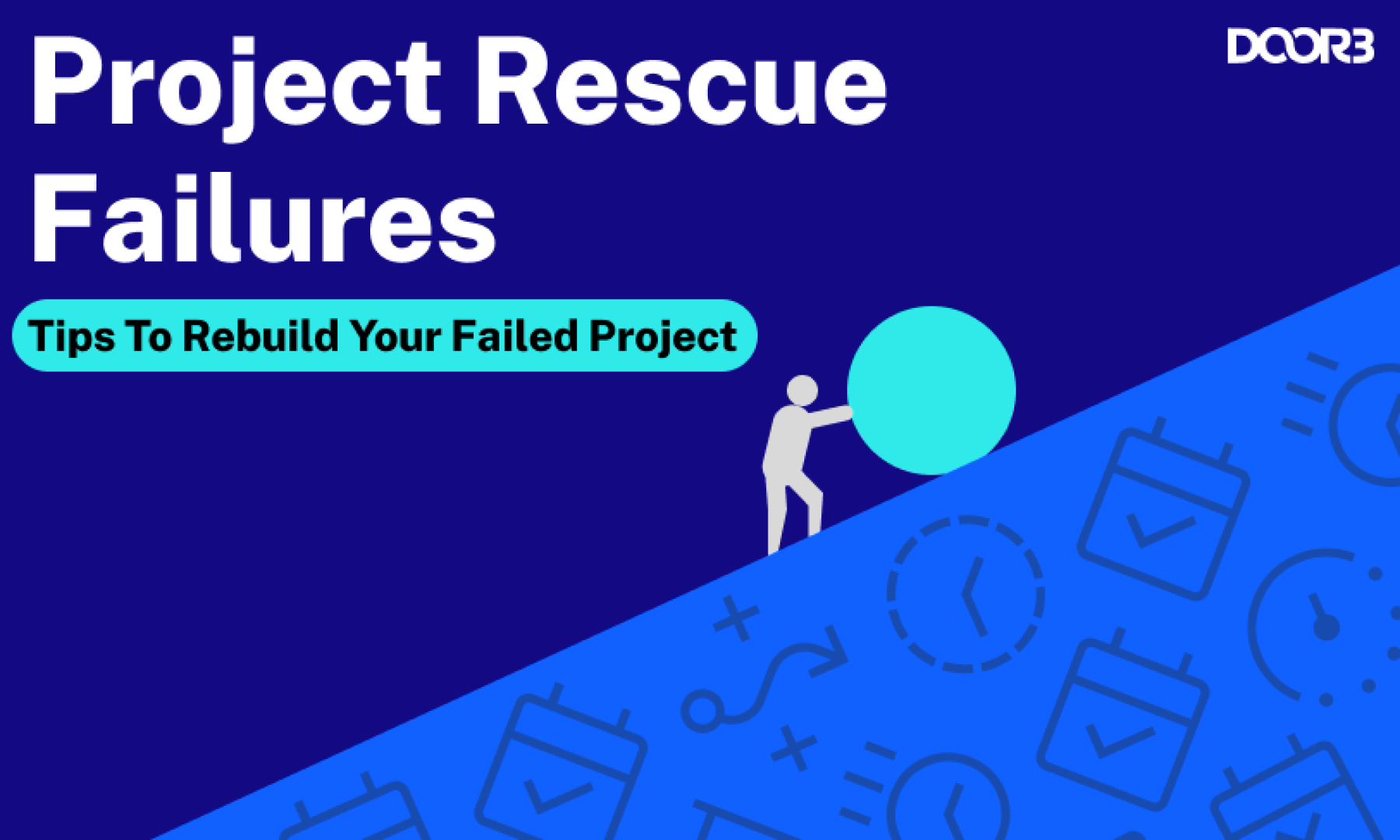Software Application Rescue: Strategies for Recovery & Revival
04.30.2024

Understanding software application rescue
Sometimes, application development doesn’t go the way you expect it to, and sometimes it REALLY goes off the rails. A software application rescue is for the latter.
But what do we mean when we say an application project has gone off the rails and is in need of a software project rescue? Well generally speaking, a software application rescue is initiated when the software project is failing or facing a daunting set of challenges. But daunting is not insurmountable, which is important to consider, as a software application rescue is meant to turn around a project before they become that would otherwise be abandoned.
Timely intervention is everything when it comes to a software application rescue. The sooner an organization reaches out to experts like DOOR3 when a project has derailed, the better the chances the project can be recovered. If you’re reading this blog because things have only just begun to not go the way you were hoping, pat yourself on the back. If things have been going downhill for longer than you’d like to admit, keep reading, it’s likely we can still help.
Common challenges warranting a software application rescue

A wealth of challenges intermingle throughout the catalog of software application rescue services DOOR3 has provided, though one of the most common we find is poor communication, an easily surmountable challenge when partnering with DOOR3.
Many times, stakeholders have not fully assessed or planned what exact application functionalities they need, how these functionalities will affect a variety of business operations they may be conducting, and the resources that are actually needed to execute the application’s development. This lack of communication leads to stakeholder misalignment which sets the stage for other issues, like scope creep, where projects expand beyond their original outlines.
Other issues that arise with scope creep include technical debt and poor code quality. As projects unconsciously expand or are delayed by disagreements, accumulated compromises in the application’s development overcomplicate the process, slowing down timelines and increasing costs. Those timeline and cost issues might put pressure on developers to build quicker, sacrificing quality in order to catch up to the original timeline.
It can be quite a slippery slope towards needing a software application rescue, luckily, DOOR3 has time tested strategies for project recovery regardless of your most intimidating complications.
How to rescue your software application

When starting a software application rescue with DOOR3, we first need to understand the severity of your situation before making any alterations to the product. It is always critical for our team to first figure out if the application in crisis is business operations integral, as if it is we prioritize quick code fixes and refactoring to get your application operational and stabilized.
1. Technical discovery
Once we’ve assessed whether or not any emergency development processes must first take place, we can begin the full assessment in the form of a technical discovery.
A technical discovery is a business holistic analysis on the application in question. We consider the project from every relevant angle to ensure that the eventually presented proposal and roadmap satisfies the needs of both the business and stakeholders.
DOOR3 roadmaps include prioritized tasks focused on high-impact solutions. We build roadmaps with Agile in mind, encouraging frequent feedback loops and opportunities for iteration. We make sure to include multiple touch points for stakeholders to jump in and provide feedback and ask questions.
2. Technical remediation
Upon proposal approval from the project’s stakeholders, technical remediation begins. This is the process of working through the prioritized task list to reduce technical debt. Debt reduction can include improving code quality through processes like refactoring and optimization. These software application rescue processes increase maintainability as well as application functionality, and by conducting these processes in an Agile environment, testing and QA are streamlined to ensure that the final product is its most technically proficient version.
3. Continuous monitoring and improvement
Once the software application rescue has reached a point of stability and stakeholder approval, we can begin future proofing the application to ensure that your organization doesn’t have to go through this process again anytime soon. Our extensive UAT and QA processes open us up to plenty of iteration opportunities, and we love working with organizations in long term formats as their go-to development partner for all things software related.
Key metrics for software application rescue success
Some of the key metrics for software application rescue include the following:
1. Application stability
Measuring the robustness and reliability of a software application can be a great success indicator. Elements to measure include crash rate, uptime/downtime, error rate, and performance metrics.
2. User satisfaction
Sometimes the easiest way to assess the success of a software application rescue is to ask the people using the application what they think. User satisfaction can be analyzed through the use of surveys, feedback forms, and monitoring support interactions. Engagement metrics like bounce rate, session duration, and conversion rates may also be helpful in measuring the success of a software application rescue.
3. Cost savings
I know what you’re thinking, “cost savings on a project that’s gone over budget and over hours?” It may sound crazy but hear us out.
Streamlined development of your application might lead to newfound reduced maintenance costs and an increase in operational efficiency. These metrics may provide cost savings in the long run while increasing your operational capacity. Also by avoiding having to abandon the project altogether your organization now has the opportunity to recoup the development costs on what otherwise would have been a money pit.
Case studies and success stories
DOOR3 has a myriad of available resources on our website, for an extended list of case studies, contact us and we will be happy to provide you with a study that matches your unique situation. Let’s take a look at a case study specific to one of our software application rescue clients.
Healthcare on life support
A prominent healthcare organization came to us facing significant challenges when a bespoke and complex intranet system was left in disarray by an employee’s abrupt departure. This failing application was a tangled web of custom spaghetti code, deeply integrated with numerous external systems, and it threatened our client’s operational efficiency.
DOOR3’s intervention commenced with a swift software application rescue operation. Our team quickly stabilized the existing system, and then conducted a thorough technical discovery to architect a modern intranet solution that would meet our client’s needs and give them room to scale as they grow.
The new intranet application we built transformed internal operations for the client, making information and tools easily accessible to employees all within a user centric design. Utilizing technology supported by Microsoft as well alleviated the burden of bespoke maintenance, extending the longevity of the application.
The success of this healthcare software application rescue project exemplifies our capabilities to handle any technically debt riddled applications thrown our way. We assess the unique challenges of each of our clients, leverage best fit technologies, and save half developed solutions that drive operational excellence. No software application rescue project is too big for DOOR3 to handle.
Collaboration and expertise
At DOOR3, we pride ourselves in being an extremely collaborative design and development company. It’s not uncommon for companies in the application development space to lack strong communication and collaboration skills, many would just like to receive instructions and execute, leading to lackluster results.
We encourage all stakeholders to be involved and engaged in the entire process. We make sure all parties receive any relevant information in as transparent a way as possible. We believe that the most effective application development processes are one where trust has been developed through genuine efforts to include everyone’s voice. Applications developed through collaboration tend to be more holistic in use, reflecting the variety of diverse perspectives added to the mix.
Not to mention, applications that are developed in collaboration with the people who use them have significantly higher adoption rates, as the end product is likely to be much closer to its most effective iteration than one developed in a silo. These higher adoption rates increase both the speed at which a project recovers and the speed of iteration, as higher adoption rates lead to more comprehensive user testing.
Trust DOOR3 with your software application rescue
With over twenty years of experience, DOOR3 is more than capable of being your go to software application rescue partner. Our team of dedicated experts can handle any questions, challenges, or software headaches you may have. Regardless of your industry, we can build an application solution that fundamentally improves the way your business operates, even if all it’s doing right now is creating roadblocks.
Have a project that needs our assistance? Contact us and let’s get started today.
FAQs

1. What is software application rescue, and when is it necessary?
A software application rescue is the process of taking over a failing software development project from a client to ensure the application is completed. A rescue becomes necessary when a project cannot progress successfully in its current state due to a variety of potential issues.
2. What are the typical signs indicating the need for software application rescue?
Typical signs include overrunned budgets, missed deadlines, increasing technical debt, declining moral, and stakeholder frustrations.
3. What steps are involved in the software application rescue process?
Steps vary depending on the unique circumstances of the rescue, though you will almost always find some kind of process that includes an overall assessment, a planning period, an implementation phase, and ongoing improvements.
4. How long does the software application rescue process typically take?
Duration entirely depends on complexity and the severity of the situation. Application rescues can take anywhere from several weeks to several months.
5. What role do stakeholders play in software application rescue?
Stakeholders should play the role of decision makers in this process. A rescue team should be presenting its findings while making plans for how they would execute the application’s rescue. It’s up to the stakeholders to ensure the proposal meets the needs of the company and to provide the resources to effectively execute said proposal.
6. How can organizations prevent the need for software application rescue in the future?
Methods for preventing rescue situations include rigorous requirement analysis, frequent audits, effective project management, and being realistic about your ability to execute said project.
7. What are the potential benefits of successful software application rescue?
The benefits of rescued software include stabilized business operations, increased functionality, improved user KPIs, and cost savings over time.
8. How can organizations measure the effectiveness of software application rescue efforts?
Organizations can measure a rescue’s effectiveness by selecting KPIs ahead of the rescue and comparing after the rescue has taken place. Relevant metrics include application stability, user satisfaction, and cost savings.
Think it might be time to bring in some extra help?
Read these next...

Request a free project quote
We will review your request and provide a project cost assessment within 1 — 2 working days.
Request a free project quote



